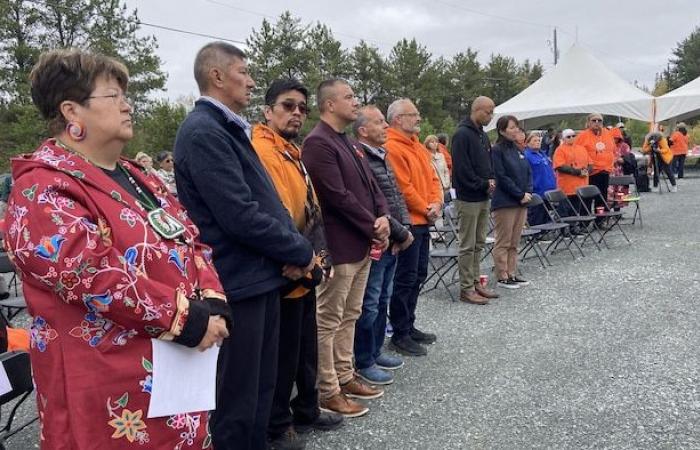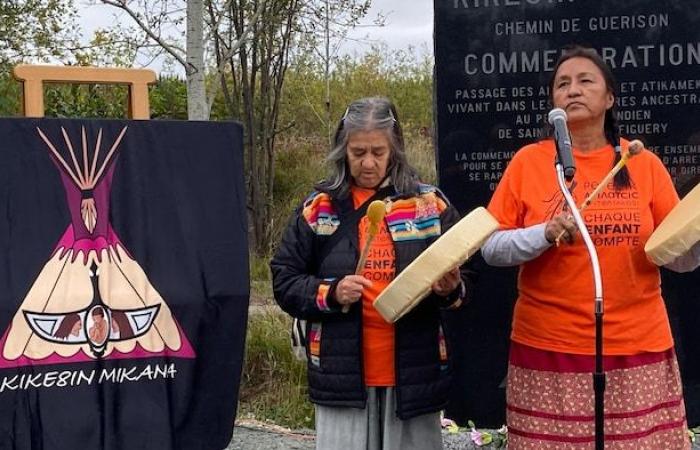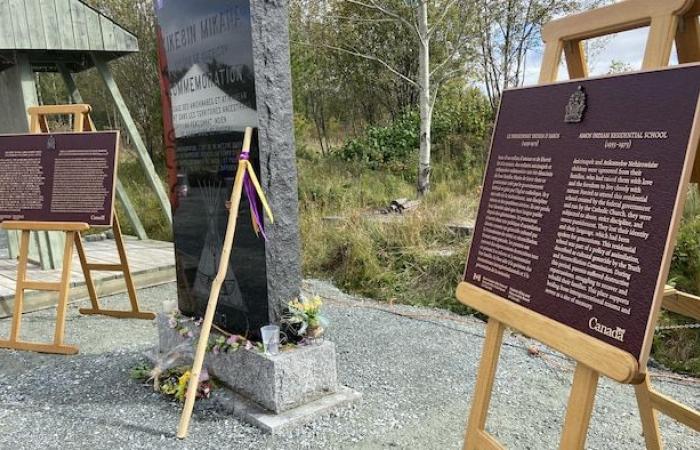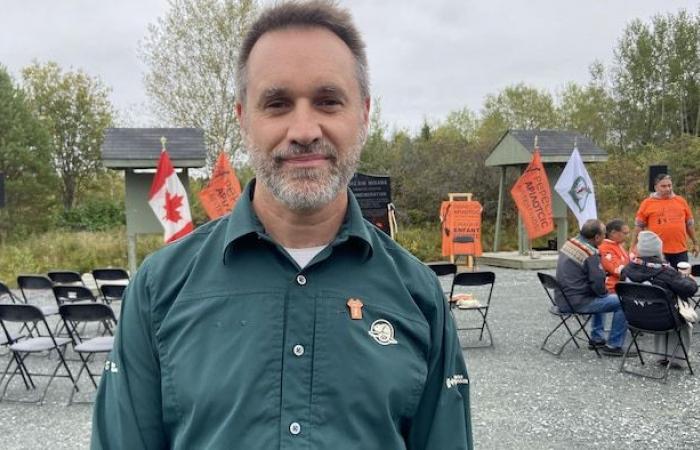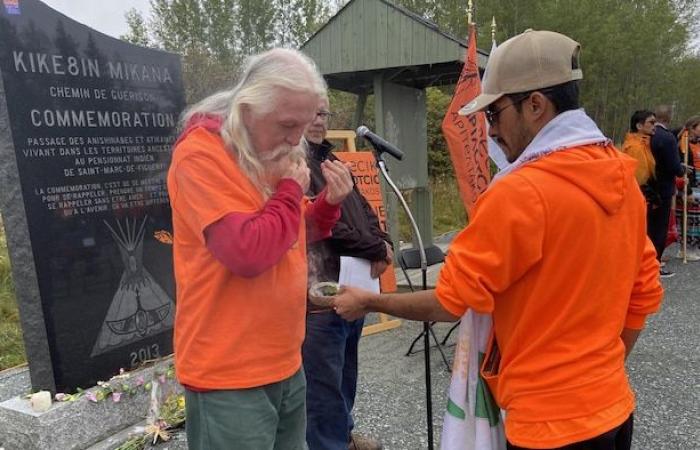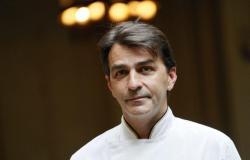To mark the National Day for Truth and Reconciliation, a ceremony commemorating history took place Monday on the site of the former residential school for Indigenous people in Saint-Marc-de-Figuery, in Abitibi-Témiscamingue.
Prayers, songs, speeches and testimonies from survivors took place during the ceremony which took place in the presence of members of the Anishinabeg communities of Abitibi and Atikamekw Nehirowisiw communities of Mauricie. The mayors of Saint-Marc-de-Figuery, André Rioux, and Amos, Sébastien D’Astous were also present.
Parks Canada unveiled two commemorative plaques recalling the suffering and mistreatment experienced by its residents, children aged 6 to 17 uprooted from their families between 1955 and 1973. The announcement was made on behalf of Minister Steven Guilbeault, responsible from Parks Canada.
Open in full screen mode
Political leaders Chantal Kistabish of Pikogan, Lucien Wabanonik of Lac-Simon, Régis Penosway of Kitcisakik, Constant Awashish of the Atikamekw Nation, and the mayors André Rioux of Saint-Marc-de-Figuery, and Sébastien D’Astous of Amos.
Photo : Radio-Canada / Martin Guindon
For us, it’s a very big day. It is the culmination of several months of work by several teams, including Parks Canada [et] the former residents of the residential school, and which also involved our sister communities of Kitcisakik and Lac-Simon, but also the Atikamekw communities in Mauricie
explains Chantal Kistabish, chief of the Abitibiwinni Nation of Pikogan.
The latter recalls that this was a request from several survivors of the residential school.
We make it a historic place today, then it is part of healing, of resilience for future generations.
Remember, to heal
Open in full screen mode
Émilie Wylde and Gloria Polson performed a song accompanying themselves with their drums at the opening of the ceremony.
Photo : Radio-Canada / Martin Guindon
These plaques are in addition to the commemorative stele installed in 2013 by the communities whose children attended the Saint-Marc-de-Figuery Native residential school. Since then, the specially designed site has hosted various ceremonies, in addition to serving as a place of meditation.
It is important to remember that these residential schools left their mark on more than one generation of Canada’s Indigenous people, according to Johnny Wylde, residential school alumni coordinator in Pikogan.
The world needs to know that it happened, especially here, but also in other places. That’s why we do this, to commemorate. These are memories that do not fade, and we must continue to live with these memories. Maybe the building is no longer there, but we remember it for example
confie M. Wylde.
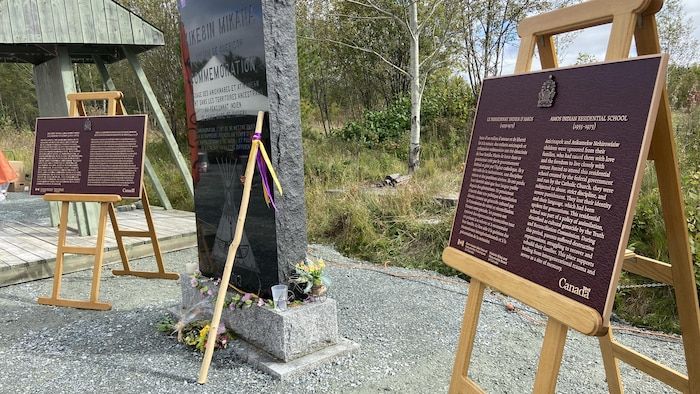
Open in full screen mode
The two bronze plaques which have just been unveiled surround the commemorative stele installed in 2013.
Photo : Radio-Canada / Martin Guindon
The great chief of the Atikamekw Nation, Constant Awashish, also sees it as an important step towards reconciliation between peoples.
I think we all want the same thing. We all want to raise our children, we want strong and proud children. We want to improve the economy, improve the culture. We want to help protect our natural resources. We want to create a better future for our children and now, we want to create it for everyone, both the general population and the different indigenous nations.
affirme M. Awashish.
Resources :
- Hope line for the well-being of First Nations: 1 855 242-3310
- National Residential Schools Resolution Hotline: 1-866-925-4419
Call to action
The Saint-Marc-de-Figuery site is the second in Canada to receive plaques commemorating the national historic event of the residential school system, after that of Shubenacadie in New Brunswick. These plaques directly respond to one of the calls to action in the report of the Truth and Reconciliation Commission of Canada.
These are two bronze plaques which will be installed in the coming weeks. A bilingual French-English plaque and a plaque in Anishinabe and Atikamekw. We have worked with the communities here and the former residents of the residential school over the last 18 months and this is the culmination of this collaborative work
specifies Dominique Foisy-Geoffroy, Director, History and Commemoration, at Parks Canada.
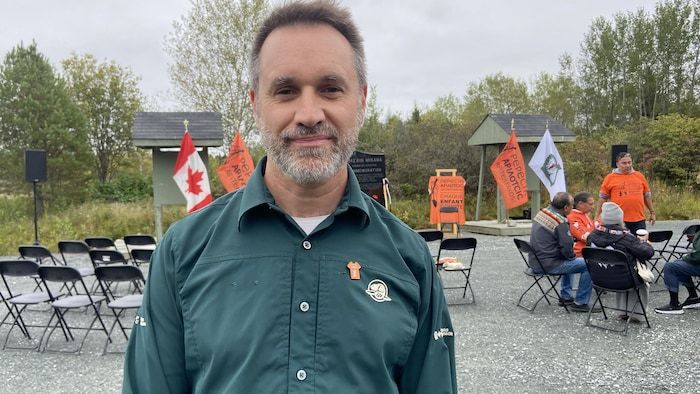
Open in full screen mode
Dominique Foisy-Geoffroy, from Parks Canada, specifies that the commemoration program is carried out with the agreement and collaboration of communities and survivors.
Photo : Radio-Canada / Martin Guindon
Indigenous communities retain management of the site, but will be able to receive support from Parks Canada. The federal agency now hopes that people will frequent the site.
We simply invite all people to come and see this place, to reflect and become aware of the importance of this place and its meaning for Aboriginal people.
says Dominique Foisy-Geoffroy.

Open in full screen mode
Participants in the Great Mamu Nikantetau March made a stop at the site of the former boarding school. Édouard Kistabish participated in the purification ceremony and offered a testimony.
Photo : Radio-Canada / Martin Guindon
The day ended with the end of Dr. Stanley Vollant’s Mamu Nintatetau Grand March, the last segment of which departed from the natural agora of Amos towards Pikogan.

